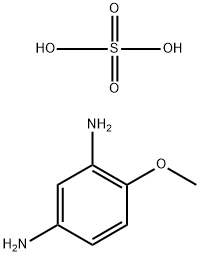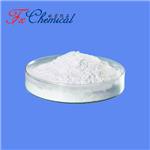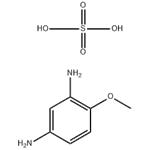Chemical Properties
2,4-Diaminoanisole is a needle-like solid.
Uses
2,4-Diaminoanisole sulfate has been used primarily as a component of oxidizing “permanent” hair- and fur-dye formulations. In 1978, about 75% of hair-dye formulations contained 2,4-diaminoanisole orits sulfate. However, a U.S. regulation requiring a warning label on allhair dyes containing 2,4-diaminoanisole or its sulfate was to become effective in April 1980, and the chemicals were voluntarily removed from products before that time (IARC 1982). 2,4-Diaminoanisole also has been used as an intermediate in the production of C.I. basic brown 2, which has been used to dye furs, acrylic fibers, cotton, wool, nylon, polyester, leather, and suede and has been an ingredient of shoe polishes (IARC 1978, 1982).
General Description
Off-white to violet or dark brown powder. Emits toxic fumes of nitrogen oxides and sulfur oxides when heated to decomposition.
Air & Water Reactions
Water soluble. Darkens on exposure to light.
Reactivity Profile
2,4-Diaminoanisole sulfate is weakly acidic. Can react as either an oxidizing agent or reducing agent.
Fire Hazard
Flash point data for 2,4-Diaminoanisole sulfate are not available; however, 2,4-Diaminoanisole sulfate is probably combustible.
Safety Profile
Confirmed carcinogen
with experimental carcinogenic,
neoplastigenic, and tumorigenic data. Poison
by intraperitoneal route. Mutation data
reported. When heated to decomposition it
emits very toxic fumes of NOx and SOx. See
also other diaminoanisole entries.
Potential Exposure
The principal use of 2,4-diamino-ani-
sole (and its salts such as the sulfate) as a component of
oxidation (permanent) hair and fur dye formulations.
Human exposure to 2,4-diaminoanisole sulfate may
possibly occur through skin absorption at chemical and dye
production facilities, as well as through dermal contact in
persons using hair dyes containing the chemical.
Carcinogenicity
2,4-Diaminoanisole sulfate is reasonably anticipated to be a human carcinogen based on sufficient evidence of carcinogenicity from studies in experimental animals.
Shipping
UN2811 Toxic solids, organic, n.o.s., Hazard
Class: 6.1; Labels: 6.1-Poisonous materials, Technical
Name Required. UN3143 Dyes, solid, toxic, n.o.s. or Dye
intermediates, solid, toxic, n.o.s., Hazard Class: 6.1;
Labels: 6.1-Poisonous materials, Technical Name Required.
Incompatibilities
Incompatible with strong oxidizers
(chlorates, nitrates, peroxides, permanganates, perchlorates,
chlorine, bromine, fluorine, etc.); contact may cause fires
or explosions. Keep away from alkaline materials, strong
bases, strong acids, oxoacids, and epoxides. The sulfate
may react violently with aluminum and magnesium.
Waste Disposal
Dissolve or mix the material
with a combustible solvent and burn in a chemical incinera-
tor equipped with an afterburner and scrubber. All federal,
state, and local environmental regulations must be
observed
.





